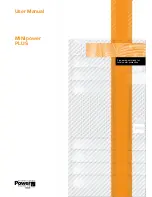
2--5
Powerware 9315 Parallel Capacity/Redundant System with PHP SSBM
164201373 Rev. A
092402
2.5.2
Setting the Power+ Trip Unit
As received, the long-time delay, long-time pickup, and instantaneous trip settings are
at their maximum values. It is the user’s responsibility to install the long-time delay,
long-time pickup, and instantaneous trip settings which are in compliance with their
overall coordination study.
Using GE Document DEH---049,
User’s Guide for the Power+
t
Trip Unit,
set the
required long-time delay, long-time pickup, and instantaneous trip settings on all
SSBM and SMB circuit breakers trip units.
NOTE:
The applicable time---current curve is GE Document GES---9890E.
2.6
Installing UPM Cabinets
To install the UPMs, refer to the
Powerware 9315 UPS Insatallation
manual provided
with the UPMs.
2.7
Installing SSBM Wiring
NOTE:
Refer to section 1.1.4 for additional guidance for wiring and conduit
placement.
NOTE:
For SSBM with100 kAIC short circuit rating, power rating must be secured
as shown in drawing 164201373---1.
1.
Install input power wiring to the SSBM and power wiring between the UPMs,
SSBM, and critical load. Each UPM is individually wired to the SSBM UPM
input bus. Refer to Appendix A of this manual for wiring and termination
requirements and wiring access information.
2.
Install control wiring between UPMs and the SSBM. PowerNet network is
wired serially (daisy-chained) between UPMs and SSBM. Wire dual redundant
PowerNet in separate conduits for maximum failure protection. Refer to
Appendix A of this manual for wiring and termination requirements and wiring
access information.
3.
If a common UPM battery is being used, a separate DC source disconnect
device must be provided for each UPM. Wire shunt/UV DC disconnect trip
and battery breaker open signals from each UPM to the respective DC source
disconnect.
4.
After wiring the Parallel Capacity/Redundant system to the facility power and
critical load(s), be sure to ground the system according to local and/or national
electrical wiring codes, using your own cabling and conduit.
5.
Install batteries in accordance with all applicable codes and regulations,
including the National Electrical Code (NEC), Article 480.
















































